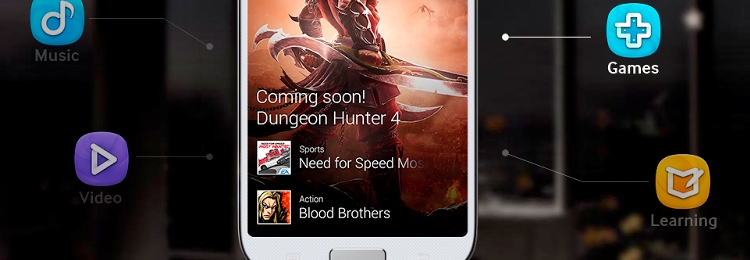Camera, Battery Life, Conclusion
Communication & Data
Gauging the strength of the Galaxy S 4's communication features is tricky because the phone is available on five different carriers, but I was only able to test Sprint's version.
As I've stated in previous reviews, Sprint's network is not very good in my area, so slow download speeds are an unfortunate reality until the Now Network manages to deliver 4G LTE to the New York City metro area.

Network performance and data speeds will vary by area. Likewise, phone call quality will also vary by network and region, but I had no complaints on any phone call. Both ends of the conversation were static free and the speaker mode was at an acceptable volume. Don't go in expecting distinguishably clear audio, but you won't have any issues hearing or being heard in a conversation.
Camera
The Galaxy Camera is a unique point-and-shoot camera with great appeal, but smartphones are Samsung's driving force at the moment, so it's only natural that the company transfers the many software tweaks and shooting modes it introduced last year to the Galaxy S 4.
The Galaxy S 4 has a 13-megapixel camera and a 2-megapixel front camera with the most sophisticated software I have ever used on a smartphone camera app. The level of customization and alterations possible are at times frustrating, but they are more often than not liberating. Thirteen shooting modes make it possible to capture any kind of moment in a variety of ways, so there's rarely a situation that the phone cannot capture.



Dual Camera is a new shooting mode that records video or takes a photo using both the rear and front cameras, then superimposes the user's face onto the video or photo. I found this feature to be incredibly gimmicky and of little value considering that lining up the front camera with your face sometimes leads to awkward positioning or distracts from the primary purpose of capturing something with the rear camera. The one time that I found Dual cam to be remotely useful is when I made faces at my infant niece in order to make her smile. It was interesting to be able to capture the comical face it took to make her laugh, but the effort didn't seem worth it.
As if the plethora of shooting modes were not enough, there's also a great deal of control for specific settings, and users will probably need to become familiar with them to take better pictures. While the Galaxy S 4's auto mode tends to do a good job of recognizing the right settings to apply, the default exposure setting is very high, which leads to some images appearing too bright. Bright and sunny days can sometimes lead to overexposure in the sky and an imbalance of photos taken outdoors or near windows. The same problem affected the Galaxy S III and Galaxy Note II, and it doesn't appear Samsung figured out the best way to fix that. Exposure, ISO, and white balance can be adjusted in the settings menu in order to get things just right.
The camera user interface is imperfect but good. The same is true of the results the camera produces. When the exposure and white balance are correctly set, the S 4 is capable of taking great photos. Colors are true-to-life depictions when the settings are controlled properly, and most photos taken were of good quality. A couple of indoor photos looked a little soft, but outdoor photos and images taken in good light looked great. The software lacks the simplicity of an iPhone 5, which provides more consistent results and takes out the guesswork out of most photos, but its flexibility leads to pleasing photos and videos on both the front and rear camera.
Battery
The Galaxy S 4 has a 2,600-mAH battery more than capable to survive the onslaught of a standard workday with moderate usage. A more demanding schedule can be tougher to handle as the phone buckled after 9 hours of heavy usage. For nearly 9 hours, I crisscrossed Manhattan, had auto-sync enabled, set brightness to 60 to 100 percent depending on my needs, and frequently used the S 4.

Battery life on the Galaxy S 4 was satisfactory but straining when pushed to it limits. Network strength and brightness settings, among other things, may affect performance, but the Galaxy S 4 has reliable battery life.
Conclusion
The sheer momentum that Samsung has built over the past four years guarantees that tens of millions of people will buy the Galaxy S 4. A few million more will be sold to those captivated by the showoff software features. The only thing that remains to be seen is if you will be among the enchanted or the disinterested.
Early detractors, present company included, said that the Galaxy S 4 is very similar to the Galaxy S III. I now believe that the phones are similar except that the S 4 is better in every single way. Samsung took every aspect of a successful device and gently tweaked them to make it better. No one should view that as a bad thing unless he or she has always had major gripes with the Galaxy S series.

The Galaxy S 4 is an advancement of an already good formula that still has room for some improvement and maturation. Months from now, when its sharing features are accessible on older devices or there are enough S 4 users in the wild to make them useful, the Galaxy S 4 will be one of the most social-friendly smartphones ever released. As of now, it's still an intriguing upgrade that builds on an engaging, albeit familiar, foundation.
score
Pros: Polished hardware and software. Improves upon winning formula. Powerful quad-core processor. User-replaceable battery. Great camera. Expandable storage.
Cons: Plastic design is not for everyone, particularly on a flagship phone. HTC One delivers tough competition.

